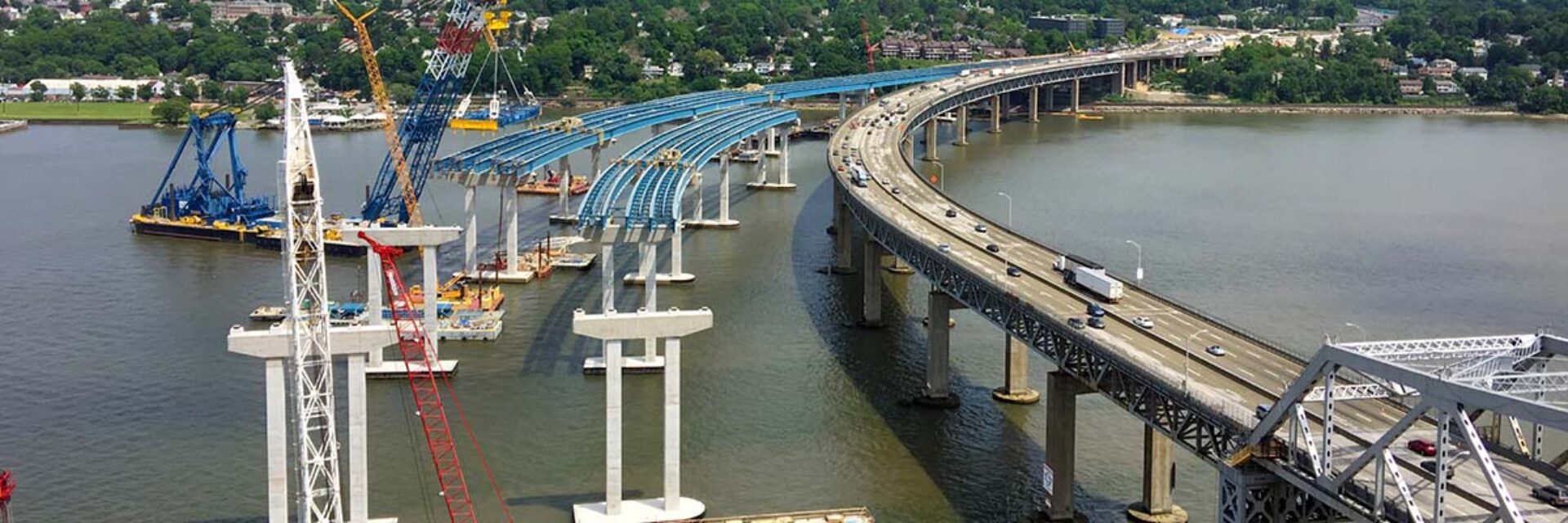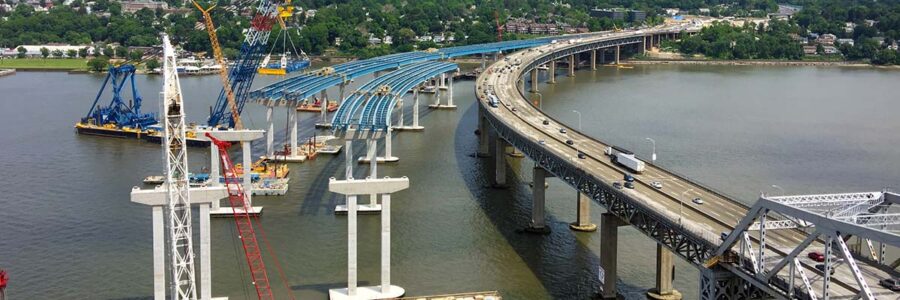
Location Tarrytown, NY
Client New York State Thruway Authority
Services Construction Management, PLA Consulting
Project Value $3.9 billion
Hill provided PLA administration and labor management services for the New York State Thruway Authority (NYSTA) during construction of the Mario Cuomo Bridge. The twin-span bridge replaced the existing Tappan Zee Bridge and carries Interstates 87 and 287 across the Hudson River, serving the tristate area of New York, New Jersey, and Connecticut. The new bridge was designed and constructed to last 100 years without major structural maintenance.
To deliver the PLA, Hill negotiated with the New York State Building & Construction Trades Council, local union representatives, and other appropriate parties to determine whether a Project Labor Agreement could be agreed upon. The PLA had to provide economic savings in the construction process through changes in work rules and practices and improve productivity, safety, efficiency, and timeliness of construction; enhance employment opportunities for minority, women, and disadvantaged persons; and allow all successful bidders, including open-shop contractors, to utilize a portion of their regular work force on the project.
At the outset, Hill performed an analysis of the current area labor environment. All applicable local building trades’ collective bargaining agreements were analyzed. This included 19 separate agreements encompassing 10 trades in each of the 2 jurisdictions involved, Rockland and Westchester Counties. The most pertinent terms and conditions in these local agreements were compared against each other and against project characteristics and requirements. They were plotted on spread sheets and were utilized throughout the negotiations by the Hill team as well as by the unions who had not previously seen such a comparison.
After nine extensive negotiation sessions over four months, several private meetings among senior representatives of both sides, and five drafts, agreement in principal was reached among all parties. The major stumbling block, the worker retention issue, was ultimately resolved by agreement that a successful non-union contractor could retain and bring to the project 12% of its currently employed non-union workers. The agreed upon PLA satisfied the above objectives set forth by the NYSTA Board and included an estimated $6.8 million in cost saving concessions. The PLA was ultimately upheld by the New York State Court of Appeals after a court challenge by non-union contractors’ associations. That decision represents the state of the law in New York and several other jurisdictions across the country upholding the validity of PLAs on major capital public construction projects.
Thanks in part to the PLA, the project proceeded on schedule and the PLA was extended several times over the project lifecycle.
We and use cookies and other tracking technologies to improve your experience on our website. We may store and/or access information on a device and process personal data, such as your IP address and browsing data, for personalised advertising and content, advertising and content measurement, audience research and services development. Additionally, we may utilize precise geolocation data and identification through device scanning.
Please note that your consent will be valid across all our subdomains. You can change or withdraw your consent at any time by clicking the “Consent Preferences” button at the bottom of your screen. We respect your choices and are committed to providing you with a transparent and secure browsing experience.
| Cookie | Duration | Description |
|---|---|---|
| cookielawinfo-checbox-analytics | 11 months | This cookie is set by GDPR Cookie Consent plugin. The cookie is used to store the user consent for the cookies in the category "Analytics". |
| cookielawinfo-checbox-functional | 11 months | The cookie is set by GDPR cookie consent to record the user consent for the cookies in the category "Functional". |
| cookielawinfo-checbox-others | 11 months | This cookie is set by GDPR Cookie Consent plugin. The cookie is used to store the user consent for the cookies in the category "Other. |
| cookielawinfo-checkbox-necessary | 11 months | This cookie is set by GDPR Cookie Consent plugin. The cookies is used to store the user consent for the cookies in the category "Necessary". |
| cookielawinfo-checkbox-performance | 11 months | This cookie is set by GDPR Cookie Consent plugin. The cookie is used to store the user consent for the cookies in the category "Performance". |
| viewed_cookie_policy | 11 months | The cookie is set by the GDPR Cookie Consent plugin and is used to store whether or not user has consented to the use of cookies. It does not store any personal data. |

